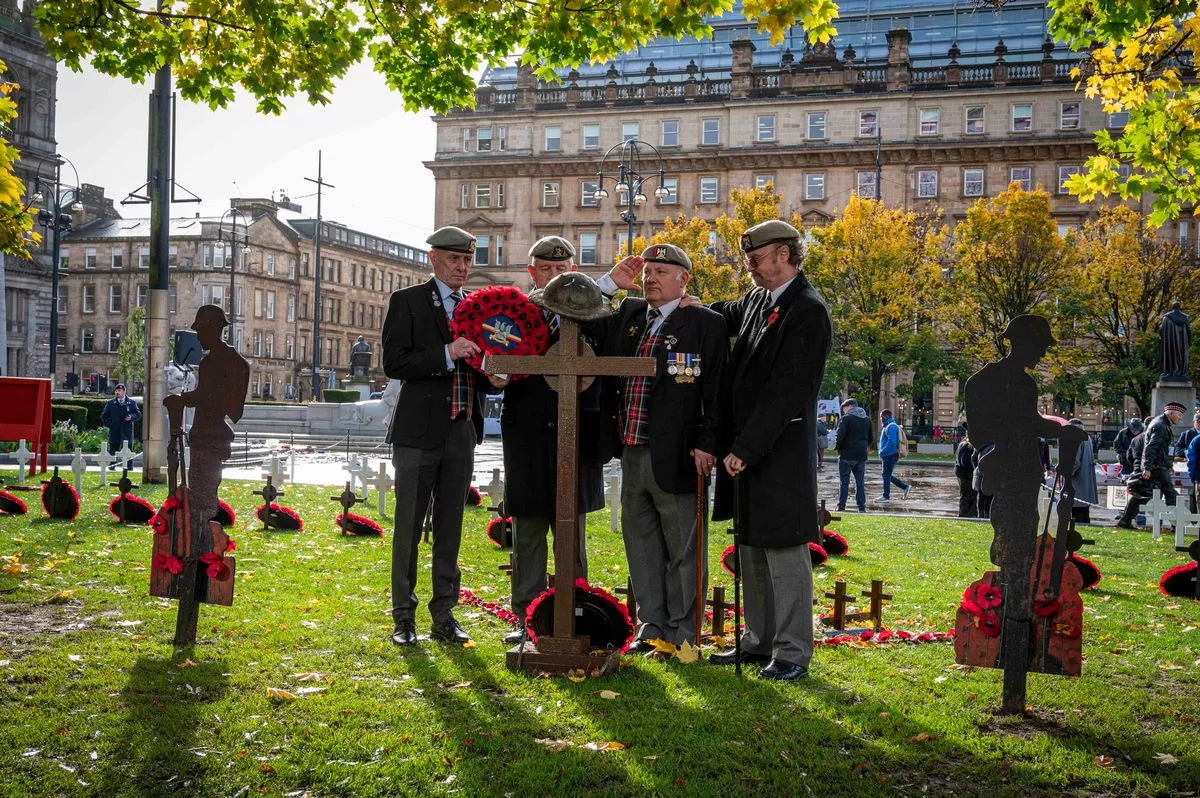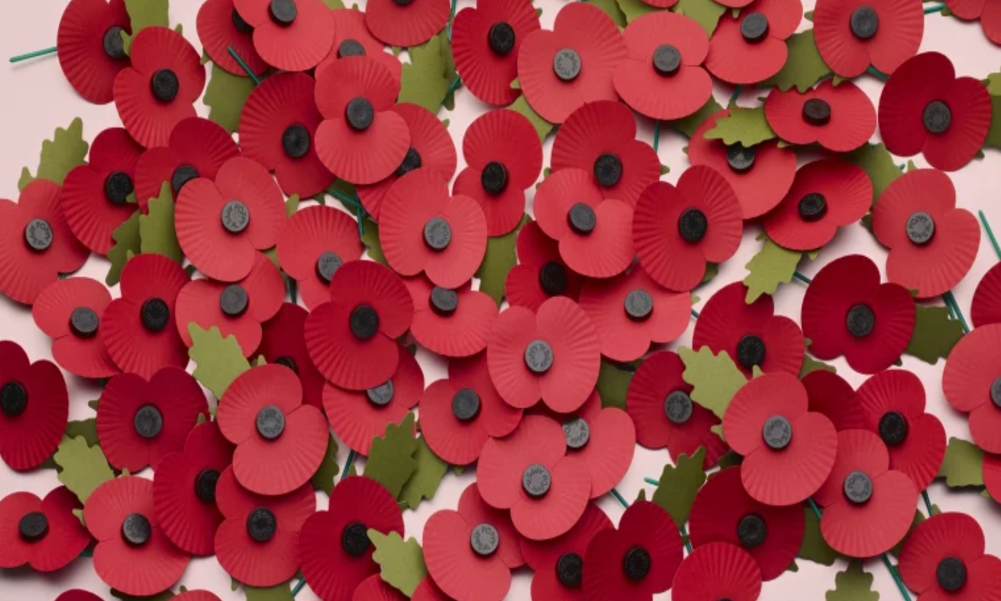By Dimitris Kouvaras,
Saturday 9th of November found me aboard a double-decker bus slowly crossing downtown Glasgow during an unsurprisingly cloudy morning. My destination was “Barras Market” at the East End, a unique flea market full of curiosities, which my best friend eagerly wanted to show me. However, looking out the damp window I noticed something else that sparked my interest. Almost at every corner of the city centre, I could see what looked like soldiers, alone or in pairs, dressed in military uniform and holding a small white box each. I was surprised and I found it unusual, considering that my only previous experience of military presence in urban centres was either guarding duty in important sights or military parades. In that case, though, there were neither guns nor marches. It took a while to complete the picture. When wandering around the city that same afternoon, we could see many people wearing little poppy brooches. After approaching one of the nearby soldiers —many of whom turned out to be volunteering youth in uniform— we discovered that the white boxes were their source. For one, the poppies must be important, I thought. While crossing the Scottish landscape on my way to Edinburg, I also noticed them painted on some hills. What was going on?
We were witnessing the so-called “poppy appeal”, an initiative in Britain and other —mainly Commonwealth— countries by the Royal British Legion to commemorate the victims of war, thence the soldiers giving out the poppies. Its primary focus revolves around the two war blasts that devastated Europe and the world, namely the First and Second World Wars, and it is timed to culminate with Remembrance Sunday, the second Sunday of November preceding the anniversary of the Allied-German armistice that ended the First World War in the western front, on November 11th. On Sunday, a public ceremony was held in the central square of Glasgow, with the presence of soldiers, officials and many civilians, which I managed to take a glimpse of. Another aspect of the campaign, which is held annually, is to gather financial support towards the needs of ex-servicing personnel who have diachronically faced issues with housing, pensions and mental health, for which a donation tab can be found on the Royal British Legion website. At this point, however, it is interesting to ask how this custom of commemoration acquired its specific character and, most importantly, symbol.
The poppy was not a random choice. British folk tradition long associated it with sleep or death, while according to an old Flemish superstition, children should avoid it lest they get contaminated with cancer, which indicates its intertwinement with decay, or its juxtaposition to life. More interesting, however, are the real conditions under which poppies have historically been found to flourish. During the Napoleonic Wars that ravaged Europe in the early 19th century, written reports emerged pointing out the appearance of poppies in the war fields alongside corpses. During the fury of the First World War, a conflict of unprecedented scale that turned much of the Franco-German borderland to rubble, leaving behind an apocalyptic scenery of mud, destruction and death, poppies would spring amidst the corpses and eventually abound in the devastated scenery. This remarkable phenomenon, which owes to the fact that poppies thrive on soil disruption, caught the attention of contemporaries, who likened the red colour of the flower to the blood of the belligerent soldiers. Canadian doctor, John McCrae, encapsulated the correlation in his poem In Flanders Fields, which he wrote in 1915, following the loss of a friend at Ypres: “In Flanders’ fields the poppies blow; Between the crosses, row on row…”. Poppies started to gain traction.

Interestingly, it was an American reader of the poem, academic Moina Michael, who first programmatically employed the flower as a symbol of remembrance towards war victims, giving it out to colleagues and campaigning for its official recognition, which the American Legion soon endorsed. Present at one of its conferences was Anne Guerin, a French woman who employed the flower’s potential as a means of financing war-struck children’s welfare in her home country and initiated the mass production of paper copies through a network of French widows. The success of the initiative in the U.S. led to it spreading to London in 1921, where it was noticed by the founder of the nascent British Legion Field Marshal Douglas Haig, who placed an order for a staggering nine million poppies for the third Armistice Day on November 11th of that year, ensuring a revenue of £ 106.000. Next year, production was transferred from France to a British factory, while the poppy soon spread to Canada, Australia and New Zealand, paving the way for an international symbol. Although nowadays the poppy appeal has died out in the U.S., it holds strong in the U.K. and other countries, where approximately 40 million paper poppies are distributed by a whopping 40.000 volunteers. Of course, this number explains why they were present in almost every corner of Glasgow that morning. Other variations exist too, like the white poppy made by the Peace Pledge Union, aiming to convey a clear pacifist tone.
The issue of remembrance is crucial, both from personal and societal perspectives. Memory as a tool does not just reclaim, but reshapes the past —or a past, be it national, personal or communal— while ceremony provides legitimacy and continuity to this reinterpretation. Who is remembered, who doesn’t, and by whom, are all factors that matter and pose significant questions. As we were walking down Edinburgh’s South Bridge Street, a local friend of mine admitted to forgetting her poppy for the first time, and another commented on how young people in general show less enthusiasm over the initiative. Arguably, as today’s youth who haven’t experienced an imminent war threat in this century get to the fore, ties with a past rooted in the last century grow fader and fader. Then it was their fathers, or even sons who lost their lives. Now, the victims are often no more than a family store or a photo on the wall. However, it is not only the people who have changed, but Britain too. It is no longer the great empire that fought the World Wars under balance-of-power and homeland security concerns, which determined the character of commemoration.

This means that the contribution of colonial subjects who were dragged into the war en masse can no longer be ignored, and pressure groups are effectively pushing in that direction. In all, ceremony as memory is not static, it cannot be. The challenge is to keep the latter afloat, but also diversify and adjust it to the demands of the day. For the remembrance of last century’s victims is hollow without empathy towards current war victims, and the glorification of war is dangerous without reference to peace.
The questions concerning commemoration today aside, I was genuinely surprised by the poppy appeal. I found the rate of participation remarkable, at least compared to initiatives in my home country Greece, while I appreciated its personal character and flexibility. One might feel unease participating in or encouraging a military parade, but wearing a poppy is a subtler and less associated with the state’s war machine way of paying tribute to the victims of war. What is also remarkable is the grassroots beginnings of the initiative, which contrasts the usual top-down state approaches to forging national memory. I believe this distinctiveness (although coupled with state sponsorship) holds it alive still.
References
- Decolonising Remembrance. The Peace Pledge Union. Available here
- The Poppy. Royal British Legion. Available here
- The poppy as a symbol of remembrance. The History Press. Available here




